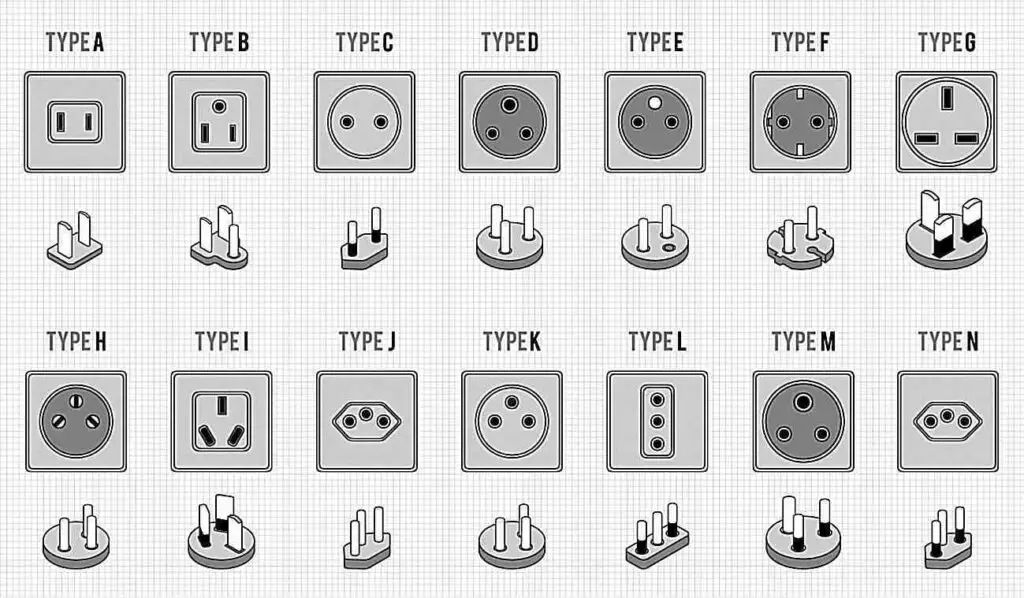When you’re preparing for a trip to Poland (or any other country), there’s more to think about than just the sights to see and the local currency. It’s also important to know what kind of electrical standards are in place. I believe this knowledge will help you understand whether you can plug in your devices directly or if you’ll need a special adapter.

Did you know that there are 14 different types of sockets used worldwide? It’s true! It’s essential to be familiar with the most common types and their corresponding voltages in Poland and other countries you might visit on your holiday. I know that many hotels, especially high-end ones, use universal sockets, but if you’re staying somewhere else or want to buy new equipment in Poland, this information is crucial.
Power Outlets in Poland
In Poland, the standard voltage is 230 V / 50 Hz, and you’ll most often find type E sockets (and less frequently type C and very rarely Type F).
Type E Socket in Poland

The type E socket is another European plug with grounding. It features two round pins arranged in a circle and a ground pin at the third vertex of the triangle. This socket isn’t exclusive to Poland. You’ll also find it in France, Belgium, Slovakia, and the Czech Republic.
↳ PRO TIP: Do you like traveling? Then before you buy any ticket or book an attraction, check if it's available in this worldwide Viator Database. You may save a lot of money and time. No need to thank me :)
Type C Socket in Poland

The type C socket is the most popular worldwide, and it’s a flat plug with two round pins without grounding. It’s used for 230 V and is widely found in Europe. However, it’s not recognized in Great Britain, Ireland, Malta, and Cyprus.
Power Outlets Across Europe

Like I mentioned earlier, the Type C socket is the most popular and well-known soket worldwide. It’s widely used in Europe, except for Great Britain, Ireland, Malta, and Cyprus. But Europe has a diverse range of power outlets, so let’s explore some of them:
- Type E: Found in France, Belgium, Poland, the Czech Republic, and Slovakia
- Type F (shuko or German socket): Used in many European countries like Germany, Austria, Spain, Sweden, Turkey, and Hungary
- Type G: Specific to the UK and features three rectangular holes
- Type J: Unique to Switzerland and resembles a smaller Type C with an additional grounding pin
- Type K: Common in Denmark and a variant of Type C with a grounding pin hole
- Type L: Sometimes used in Italy alongside the more common Type F (shuko) socket
Power Outlets in the Americas
The Americas have fewer variations in power outlets compared to Europe. The most common types are Type A and Type B.
- Type A: Used in countries like the USA, Canada, Mexico, Venezuela, Colombia, Ecuador, and Peru
- Type B: Similar to Type A but with an additional grounding hole, used in the same countries as Type A, except for Mexico, Nicaragua, and Bolivia
Some countries have additional socket types:
- Guatemala: Uses Type I and Type G alongside Types A and B
- Guyana: Employs British standards Type G and Type D, as well as American Types A and B
- Suriname: Features European sockets in F and C standards
- French Guiana: Utilizes E and C standards
- Brazil: Has its own Type N socket with three round pin holes
- Paraguay: Consistently uses Type C, which is also found in Argentina alongside Type I
- Chile: Offers both Type C and Type L sockets (Italian socket type)
Power Outlets in Africa
In Africa, the influence of the colonial era can still be seen in the power outlets. For popular holiday destnations:
- Egypt: Uses Type C standard
- Tunisia: Features Types F and C sockets
- Morocco: Offers Types E and C sockets
Power Outlets in Australia and Oceania
For those traveling to Australia and New Zealand, you’ll only find Type I sockets. These have holes for two flat pins set at a slight angle and a third grounding pin.
Power Outlets in Asia
Asia has a diverse range of power outlets as well:
- China: Uses American Type A, European Type C, and Type I sockets (all at 220V, 50Hz)
- Japan: Features American Type A sockets, but with a lower voltage of 100V
- Thailand: Offers four different types – American (Type A and B) at 220V, 50Hz, and European Types C and F
- Israel: Utilizes Type H sockets (with three flat pins arranged in a V shape), Type D (former British standard), and the globally common Type C (without grounding)
Complete List of Electrical Socket and Plugs in The World
Here’s a complete list of the different types of electrical sockets and plugs you might come across during your travels:
- Type A: Two flat pins of different widths, arranged parallel to each other. Usually used with a voltage of 110V, mainly in North and Central America (USA, Canada, Mexico, Guatemala, Cuba) and Japan.
- Type B: An „extended” version of Type A with an additional grounding pin. Used in the same countries as Type A plugs.
- Type C: A flat plug with two round pins without grounding, used for 230V. Widely used in Europe (Poland), but not recognized in Great Britain, Ireland, Malta, and Cyprus.
- Type D: An old British standard with three round pins arranged in a triangle. Currently used mainly in Asia (e.g., India, Nepal, Namibia, Sri Lanka).
- Type E: A European grounded plug with two round pins and a grounding pin. Used in Poland, France, Belgium, Slovakia, and the Czech Republic.
- Type F (schuko): Similar to Type E, but with two metal clips instead of grounding. Mainly used in German-speaking countries in Europe (Germany, Austria, Netherlands, Sweden, Norway).
- Type G: A classic British plug with three rectangular pins. Used in the UK, Ireland, Cyprus, Malta, Singapore, Hong Kong, and Malaysia.
- Type H: A plug with three flat pins arranged in a V shape, used only in Israel and the Gaza Strip.
- Type I: Equipped with two flat pins set at a slight angle and a grounding pin. Common in Australia, New Zealand, Papua New Guinea, and Argentina.
- Type J: Similar to Type C, but with an additional grounding pin. Used in Switzerland and some African countris.
- Type K: A Danish version of Type C with a grounding pin in the lower part. Used in Denmark, Maldives, Senegal, and Bangladesh.
- Type L: An Italian version of Type C with a grounding pin in the middle. Found in Italy, Tunisia, and Ethiopia.
- Type M: Equipped with three round pins arranged in a triangle. Mainly used in South Africa.
- Type N: Has three round pins arranged in a flat triangle, with grounding at the top. Used in Brazil and South Africa.
So, if you want to make sure you can charge your devices during your travels, it’s worth knowing the power socket types in your destination countries and having the right adapter in your luggage.
Power Adapters Commonly Used by Travelers
Below is a list of popular travel adapter models to help you stay connected while traveling:
- DPM DPM PF05 travel adapter kit
- Ecolite 4xUSB travel adapter
- SKROSS Pro Travel Adapter
- SKROSS travel adapter 1.500230
- Brennenstuhl GB/PL travel adapter
- TRAVELIGHT SKROSS travel adapter 1.500215
- Skross Travel Adapter AKGADSKRLLMPROB02
- Hama Travel adapter US plug
- Hama Travel adapter English plug
- Brennenstuhl US/Japan Uni-Schuko Travel Adapter
These travel adapters are designed to work with different types of sockets and plugs worldwide. It’s essential to research and choose the right adapter based on your destination country and the devices you plan to bring. Remember to check the voltage compatibility and ensure that your devices can handle the voltage in the country you are visiting.
Preparing for Different Voltages Around the World
It is essential to be prepared for differences in voltage and frequency when traveling to different countries. Electrical outlets worldwide run at a voltage of 100 to 240 volts. Most of the world’s voltage ranges from 220 to 240 volts, but there are some significant exceptions:
- Voltage in Poland and other European countries is 230V
- Voltage in Canada is 120V
- Voltage in the USA and Central America is 110V
- Voltage in Japan is 100V
Before leaving for your trip, it is crucial to check whether the power supplies of the devices you plan to bring can handle the voltage in your destination country. Most newer equipment or USB chargers come with universal power supplies, ensuring they work in Europe, North America, and Japan. However, if you plan to take older devices, double-check the housing or specification for compatibility.
If the description contains information like INPUT: 100-240V, 50-60 Hz, this means the power supply is universal and supports any voltage and frequency. If not, you will need appropriate power supplies or a transformer that will convert the local voltage to the value your equipment is adapted to.
In summary, understanding the differences in voltages and frequencies in various countries and ensuring your devices are compatible with them is essential for a hassle-free trip. So, before setting off on your journey, double-check your equipment’s compatibility with the voltage and frequency of your destination country, and pack the necessary adapters and transformers if needed.
Frequently Asked Questions
Here are some most common questions people ask:
Is Power Outlet in Poland The Same As it is in Germany?
Yes, the power outlets in Poland and Germany are the same. Both countries use Type E sockets, with a voltage of 230V and a frequency of 50Hz. You can use your electrical devices in both countries without needing a separate adapter, as long as your devices are compatible with these outlets.
References:
- https://www.termaoutlet.pl/porady/czym-r%C3%B3%C5%BCni%C4%85-si%C4%99-od-siebie-wtyczki-w-r%C3%B3%C5%BCnych-krajach
- https://blog.swiatbaterii.pl/rodzaje-gniazdek-elektrycznych/



